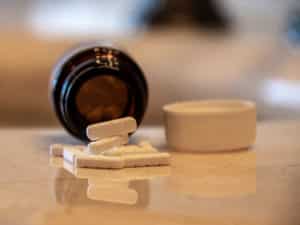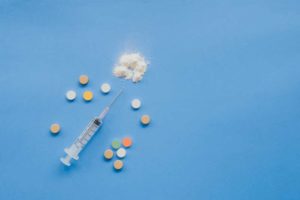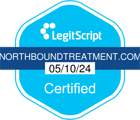As a solution to the opioid crisis in the United States there is a strong effort by the Centers for Disease Control and Prevention (CDC), the National Institute on Drug Abuse (NIDA), and the American Society of Addiction Medicine (ASAM) to make medication-assisted treatment (MAT) accessible to everyone who needs it. At Northbound, we support this policy and have designed our treatment protocols to meet this standard and allow it to complement the high-quality care we have long delivered.
MAT is often misunderstood to only include methadone and buprenorphine/naloxone (BUP/NX, or Suboxone). These medications are agonists at the mu-opioid receptor — they turn it on and produce classic opioid effects: sedation, euphoria, pain relief and a host of other brain and body-based effects such as itching, nausea and urinary retention.
Methadone and BUP/NX are evidence-based treatments with proven effectiveness that have helped and will continue to help many people find their way into long-term recovery.
Senior Recovery Advisor Dr. Kevin McCauley collaborates with the clinical team on the orchestration of Northbound’s monthly four-day, on-site family program, in addition to his addiction education work with clients, enhancements of the clinical program and assistance with family support and interventions. Dr. McCauley is the co-founder of The Institute for Addiction Study who has directed two films, “Pleasure Unwoven” (on the neuroscience of addiction) and “Memo to Self” (on the recovery management of commercial airline pilots with substance use disorders). “Pleasure Unwoven” won the 2010 Michael Q. Ford Award for Journalism from the National Association of Addiction Treatment Providers (NAATP).
It should be remembered, though, that these medications are also intoxicants, and, although they are certainly under-utilized in the United States, are not appropriate for all patients.
What is often forgotten in discussions about MAT is the third medication this treatment includes: the opioid receptor antagonist naltrexone.
Naltrexone is the orally-administered and longer-acting sibling of nasal- or injection-administered and shorter-acting naloxone (Narcan). Interestingly, naltrexone is well known to decrease cravings for alcohol and decrease drinking days in people with alcohol use disorder who relapse. Since compliance with the once-a-day naltrexone tablet is problematic, an extended-release preparation of naltrexone in the form of a once-every-30-days injection exists (Vivitrol). XR-NTX (Vivitrol) has been shown to treat cravings and prevent relapse in patients with alcohol use disorder. It is also approved by the FDA for the treatment of opioid use disorder in patients who have undergone detoxification from opioid drugs.
Northbound uses both buprenorphine/naloxone (BUP/NX) and extended-release naltrexone (XR-NTX) in our capacity to provide evidence-based MAT to our clients so they have the best chance of establishing and maintaining long-term recovery.
Prejudices and stigma abound with MAT, and there are those who support the use of methadone and buprenorphine over the antagonist naltrexone. Since naltrexone is not an intoxicant, many correctional programs and probation departments favor naltrexone over methadone and buprenorphine. Those who support buprenorphine accuse naltrexone of being an inferior form of MAT.
Recently, California Congressmember Kamala Harris announced her intentions to investigate the manufacturer of XR-NTX for their marketing practices, especially those involving jails and probation departments that advocate the use of naltrexone over methadone and buprenorphine.
“We need more transparency into their aggressive lobbying and marketing campaign,” Congressmember Harris stated. “Cheaper and more thoroughly studied treatments appear to have been stigmatized and marginalized.”
Northbound is eager to fight the stigmatization and marginalization of any treatment that can relieve suffering and prevent death of any person in or in need of recovery. But we also feel that the effort against such stigmatization or marginalization is not well-served by the demonization of a drug that is not a maintenance agonist.
Fortunately, in October and November 2017, two studies were published that indicate that extended-release naltrexone (XR-NTX) is at least as effective as buprenorphine/naloxone (BUP/NX), and in both publications the authors recommend that both treatments be seen as equally effective options for persons with opioid use disorder.
The first study (Tatum, 2017) was conducted at five treatment programs in Norway. It included 159 opioid-dependent but fully detoxified subjects randomized to treatment with BUP/NX or XR-NTX and followed for 12 weeks.
The authors found that both forms of MAT were equal in their ability to reduce heroin use, reduce injecting behavior, reduce the use of other illicit substances (except, frustratingly, cannabis use), and improve retention in treatment. Importantly, the medications were equally effective at lowering cravings for opioids, which naltrexone, in not possessing agonist effects at the mu-opioid receptor, might be assumed to lack compared to buprenorphine — a partial agonist at the mu-opioid receptor.
“Maintaining short-term abstinence with extended-release naltrexone should be considered an equal treatment alternative to buprenorphine-naloxone as medication-assisted treatment for opioid-dependent individuals,” the authors concluded.
The second, larger study (Lee, 2017) randomized 570 subjects to XR-NTX or BUP/NX treatments and followed them for six months. Some participants were recruited and randomized while in detoxification and were not appropriate for immediate XR-NTX induction, and XR-NTX showed more dropouts than BUP/NX. The study confirmed that it is harder to start naltrexone than buprenorphine; the waiting period necessary to ensure that the NTX will not precipitate a counter-therapeutic and even cruel withdrawal state is its disadvantage. But for those patients who could get through detox and start either medication the risk of relapse was the same, number of negative urine samples and days of abstinence were the same, overdoses and other adverse events were the same, and with regard to remaining in treatment, XR-NTX has a slight advantage (16 weeks) over BUP/NX (14 weeks).
Again, quite fascinatingly, both XR-NTX and BUP/NX decreased self-reported cravings for opioids! Sadly, five study participants died of overdoses during this trial: two in the naltrexone group and three in the buprenorphine group. But, the authors concluded, “If induction to either medication is successful, XR-NTX and BUP-NX were comparably effective and safe options. These findings afford providers, patients, and families a choice between agonist and antagonist therapies.”
We have, at Northbound, always believed this was true, and it is gratifying to see a growing number of studies showing evidence to support the two kinds of MAT we provide. But the Lee study reminds us that, whichever form of MAT utilized, the induction phase is critical. People starting out on their path to long-term recovery need a lot of support and compassion as they choose the treatment that is right for them. Wrap-around psychosocial and therapeutic supports are imperative in maximizing chances for success. The clinicians and staff at Northbound provide a competent, kind and safe place for that healing to begin.
Author
-

President, CEO & Founder at Northbound Treatment Network
Paul Alexander is the CEO, President & Founder of Northbound Treatment Network in Newport Beach, California. He believes wholeheartedly in transformational leadership, organizational health and effective, fully integrated substance use disorder and mental health treatment. With over 27 years of experience in behavioral healthcare, Paul has extensive knowledge of “in vivo” treatment modalities, clinical development, operations, strategy, marketing and financial planning. He has been widely recognized for his development of collegiate-based residential treatment programs for students in recovery and authored a research study at The University of California confirming this modality’s effectiveness.
Paul’s comprehensive professional experience, willingness to innovate, and emphasis on organizational health are vital factors in Northbound’s continued success. Paul received his Certified Addiction Treatment Specialist training at Saddleback College in Mission Viejo, CA, and was awarded Outstanding Alumni Service Award in 2002. Paul holds a Bachelor of Arts degree in Criminology, Law and Society, Summa Cum Laude, from University of California, Irvine, and a Juris Doctorate degree from Loyola Law School of Los Angeles. Paul currently serves on The National Association of Addiction Treatment Providers (NAATP) board. In addition, he serves on The Family Recovery Foundation board and The CarePossible board in Orange County; both organizations are committed to raising funds for family recovery and treatment for former military personnel. Paul is in recovery himself and lives in Orange County with his wife Silvana and his two young sons, Noah and Dean.










